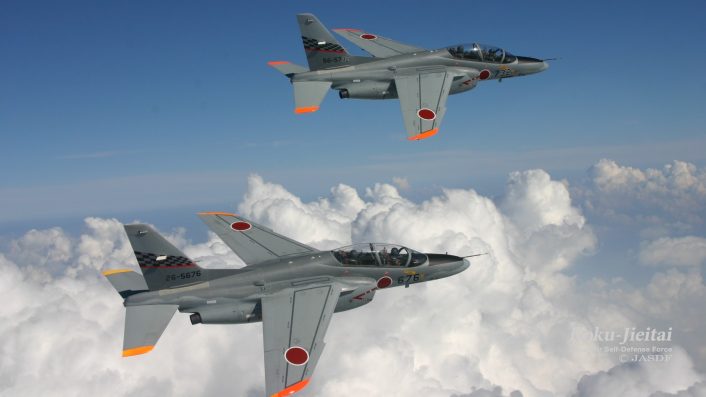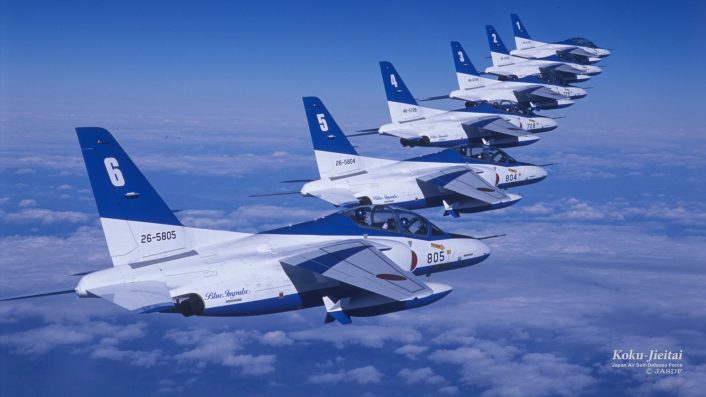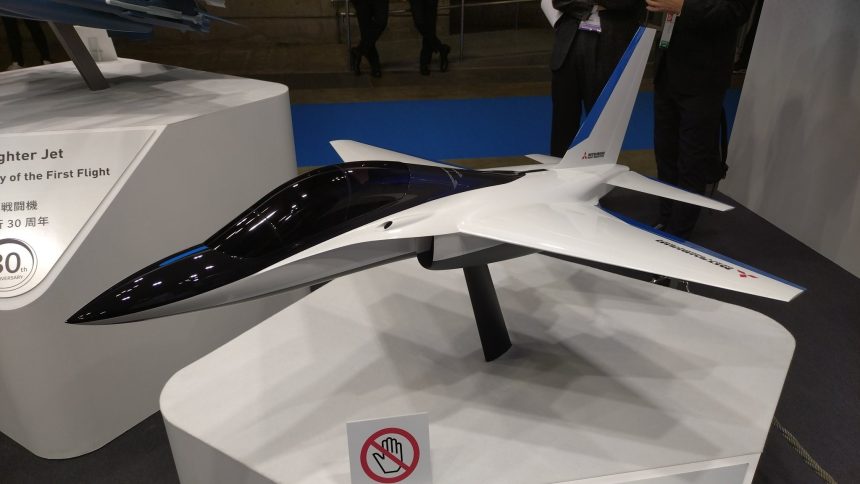Japan has been looking to replace its older T-4 jet trainer, as Tokyo requires more modern aircraft to prepare pilots for the advanced F-35s and the upcoming GCAP.
New images recently emerged from the ongoing DSEI exhibition in Chiba, Japan, showing a scale model of a concept twin-engine advanced jet trainer being presented by Japan’s Mitsubishi Heavy Industries (MHI). Called the “T-X Domestic Development Concept,” the notional aircraft might be a contender for the replacement of Japan’s current jet trainer, the Kawasaki T-4.
The photos of the model come a few days after a T-4 with two personnel onboard crashed on May 14, 2025, shortly after taking off from Komaki Air Base in central Japan’s Nagoya, according to Kyodo News. It has been later confirmed that the two crew members have lost their lives and the T-4 fleet has been temporarily grounded.
As per Kyodo, the Japan Air Self-Defense Force (JASDF) operates 197 of the domestically-made T-4s, used for advanced jet flight instruction after the basic flight training on the Fuji T-7. The T-4s are also used by the service’s Blue Impulse aerobatic team. The T-7 itself is soon to be replaced by the T-6 Texan II as the new primary flight training aircraft, after Tokyo’s Ministry of Defense (MoD) chose the U.S.-made aircraft in Nov. 2024.
三菱重工様より、自社開発コンセプトの次期練習機、UGV、後は30FFM(もがみ改良型)#DSEI #DSEIJapan#DSEIJapan2025 pic.twitter.com/wboYmcH6fy
— 陸野ゆうの@🪖元陸自ミリタリー系VTuber (@Rikuno_Yuuno) May 21, 2025
Concept T-X jet trainer
The T-X’s design configuration appears largely similar to Italy’s M-346 Master trainer and Russia’s Yak-130, particularly in terms of the exhaust nozzle placement and the tail section. The nose section, however, appears to be slightly longer and sleeker. This could however be subject to change if and when the design is finalized and a prototype goes into a production.
皆さんがこの三菱重工次期練習機コンセプトモデルのコックピット左側にある穴は機関砲?という質問沢山あったので改めて三菱重工様に聞いてきました。
結論:GUN(機関砲)です。
コンセプトとして色々と考えているよです。詳しいお話を仕事の記事に回すか、個人の動画に回すか迷ってます。 https://t.co/UgHHsU8xgH pic.twitter.com/dsZZZgNSQX
— 陸野ゆうの@🪖元陸自ミリタリー系VTuber (@Rikuno_Yuuno) May 21, 2025
A feature on the T-X also saw observers in the thread asking whether a hole on the left-side leading root wing extension was a port for a gun/cannon and questioned the wisdom of the feature, given the complicated engineering required on that class of a small, light aircraft.
X user ‘Rikuno_Yuuno’, who posted the image of the T-X scale model at DSEI, was able to get confirmation from MHI officials that it was indeed a gun. The concept does not show an aerial refueling probe, but it is unlikely to be absent in a future prototype or a production variant.
三菱重工、次期練習機T-Xのコンセプト初公開 白に黒と青配すハウスカラー=DSEI Japan https://t.co/f9rAp5q6Jh pic.twitter.com/0Gu6RlpszP
— Aviation Wire (@Aviation_Wire) May 21, 2025
T-4 crash
The T-4 that crashed on May 14 took off from Komaki Air Base at around 3:06 pm local time and was “en route to a base in southwestern Japan,” when it crashed in the Lake Iruka reservoir near Inuyama city in Aichi Prefecture, according to Kyodo. Defense Minister Gen Nakatani told journalists that a part of the jet was found near the crash site, while JASDF chief of staff Gen. Hiroaki Uchikura identified the two missing pilots as a Captain and a First Lieutenant.
The Japan Times identified the missing pilots as Capt. Takuji Ioka (31) and 1st Lt. Shota Amitani, (29) of the 5th Air Wing. Parts recovered by the search team belonged to the T-4’s engines, wheel tires, pilot seats and oxygen cylinders. Mainichi Shimbun, in an editorial, further added that the T-4 “suddenly descended while making a right turn […] after climbing to an altitude of 1,400 meters […] suggesting the possibility of an abrupt malfunction,” adding there was “no sign that the two crew members ejected.”

Uchikura also announced suspending “T-4 flights for the time being,” and added that the ill-fated aircraft – that belonged to the Nyutabaru Air Base in Miyazaki Prefecture – was manufactured 36 years ago and did not have flight recorders. The T-4 is a high-subsonic aircraft, developed to replace the Lockheed T-33 and Fuji T-1, while also substituting a lot of the training syllabus imparted from the Mitsubishi T-2.
The first prototype flew in 1985 and the aircraft entered service in 1988. The T-4 had also been previously grounded following an incident on Apr. 2, 2019, when a crew departing Misawa air base “heard abnormal noise and felt vibrations from the number two engine, after which the crew declared an emergency and returned safely,” according to Scramble. A subsequent investigation found a detached turbine blade, with the JASDF on Apr. 19, 2019, announcing the decision to replace the concerned engine part on the entire T-4 fleet.

T-X or other trainers?
Little is known about the T-X trainer, and there have been no reports from Japan about the JASDF or the MoD embarking on a homegrown aircraft to replace the current trainer jet. Interestingly, however, the country was reported by the Mainichi Shimbun in Mar. 2024, to have identified the Boeing-Saab T-7A Red Hawk as the possible candidate.
A deal to jointly develop the T-7A, or at least a Japan-specific version, was expected to be signed during former Prime Minister Kishida Fumio’s visit to Washington on Apr. 10, 2024. While no formal announcement has been made yet, the T-7A does appear to be a front runner.
Joint manufacturing that jet with Japan for a larger order attains economies of scale, lowering development and production costs, while also enforcing interoperability from the training stage itself, as both countries operate F-35As, F-35Bs and F-15s. This would also depend on the timelines set by Japan, as the T-7 is not yet in production.
The first Boeing T-7A Red Hawk successfully arrived at Edwards Air Force Base, California, Nov. 8, 2023.
Air Force photo by Bryce Bennett pic.twitter.com/sXvi8zVmWO
— Fighterman_FFRC (@Fighterman_FFRC) November 9, 2023
How Mitsubishi’s T-X therefore fits into this scheme of things remains to be seen. With Japan inducting more F-35s, especially the STOVL F-35B variant to operate off its JS Kaga and JS Izumo carriers, and developing the sixth generation Global Combat Air Program (GCAP) along with the UK and Italy, Tokyo does need a more current jet trainer to prepare pilots for the advanced aircraft.
Leonardo’s M-346 might be another candidate, as the Italian company showcased the cockpit simulator of the new Block 20 configuration with the name M-346J Block 20,as well as the Italian and Japanese flags, possibly hinting at the intention to pitch the aircraft for the replacement. The M-346 has also been proposed as the ideal trainer to train GCAP pilots.
🇮🇹🇯🇵
For DSEI 2025 JP, Leonardo is showcasing what the cockpit will look like for the M346 Block 20 once again, it’s the same rig shown at MFT 2025, this time though they have marketed this as the “M346J Block 20”, perhaps Japan will adopt this version of the M346 in the future. pic.twitter.com/Uu8ORH0xYf
— A-129 Mangusta (@NichoConcu) May 22, 2025
Eye on exports
The fact that Mitsubishi, with a credible aerospace history dating back to World War 2 and a very likely participation in the GCAP, fielded such a concept in a defense exhibition, also means it does see a future for the aircraft, especially for foreign sales.
せっかくですので、本日のDSEI Japan 2025で撮影した写真や動画をシェア致します😊
まずは #次期戦闘機 こと #GCAP pic.twitter.com/osvw0UoxPK
— 高橋浩祐(たかはし こうすけ)Takahashi Kosuke🐺 (@KosukeGoto2013) May 21, 2025
For instance, the above-mentioned gun port on the T-X, or even a heavily weaponized variant like the Yak-130 or the M-346, might not necessarily be a reflection of a JASDF’s need for a light attack aircraft. However, these lightly armed jets have a massive utility in intercepting standoff ballistic and cruise missiles while coordinating with ground-based SAMs and AEW&C aircraft.
These are also the threats the SDF faces from North Korea and China. Such a version therefore however cannot be ruled at this stage, especially as Japan is displaying a desire to adopt more domestic solutions to its defense needs. An armed configuration also targets foreign customers with that need, in a highly competitive international market for primary and advanced jet trainer aircraft.
With South Korea and Turkey also fielding their FA-50 and Hurjet aircraft and actively targeting foreign buyers, Japan has entered the fray significantly late, and would be constrained by the T-X still being in a concept stage and not yet been chosen by the developer country (Japan), let alone being used. The T-X concept display also comes amid Japan slowly lifting its self-imposed embargo on defense exports, with Tokyo now making its defense commercial policy more attractive.









